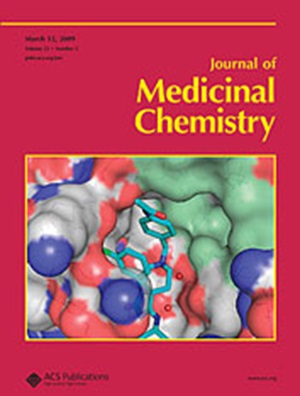Development of a Highly Efficient NIR-II Phototherapeutic Agent for Fluorescence Imaging-Guided Synergistic PTT/PDT/Chemotherapy of Colorectal Cancer
IF 6.8
1区 医学
Q1 CHEMISTRY, MEDICINAL
引用次数: 0
Abstract
NIR-II-triggered phototherapy presents a noninvasive, resistance-free alternative therapeutic approach with deeper tissue penetration and improved imaging of deep tumors. However, many NIR-II phototherapeutic agents suffer from low fluorescence quantum yields, poor photothermal conversion efficiency (PCE), and reduced efficacy due to the upregulation of heat shock protein HSP70. This study develops a small-molecule NIR-II phototherapeutic agent (IRF) with a high fluorescence quantum yield (17.4%), excellent PCE (96.8%) for photothermal therapy (PTT), and photodynamic therapy (PDT) activity. To decrease thermal resistance during phototherapy, IRF and evodiamine (EVO) were loaded onto hyaluronic acid (HA)-modified nanoparticles, creating a multifunctional nanoplatform termed EVO/IRF@HA NPs. EVO/IRF@HA NPs can actively target tumors for NIR-II fluorescence imaging via the HA moiety. Upon 980 nm laser irradiation, IRF increases the temperature and content of reactive oxygen species for synergistic PTT/PDT. Importantly, EVO effectively inhibits the overexpression of HSP70, enabling combined PTT/PDT/chemotherapy for effective colorectal cancer (CRC) treatment.

荧光成像引导结直肠癌PTT/PDT/化疗高效NIR-II光治疗剂的研制
nir - ii引发的光疗提供了一种无创,无阻力的替代治疗方法,具有更深的组织穿透和改善深部肿瘤的成像。然而,许多NIR-II光治疗剂存在荧光量子产率低、光热转换效率(PCE)差、热休克蛋白HSP70上调导致疗效降低等问题。本研究开发了一种小分子NIR-II光治疗剂(IRF),具有较高的荧光量子产率(17.4%),良好的PCE(96.8%),用于光热治疗(PTT)和光动力治疗(PDT)活性。为了降低光疗过程中的热阻,将IRF和evolodiamine (EVO)加载到透明质酸(HA)修饰的纳米颗粒上,创建了一个多功能纳米平台,称为EVO/IRF@HA NPs。EVO/IRF@HA NPs可以通过HA部分主动靶向肿瘤进行NIR-II荧光成像。在980 nm激光照射下,IRF提高了PTT/PDT的温度和活性氧含量。重要的是,EVO能有效抑制HSP70的过表达,使PTT/PDT/化疗联合治疗结直肠癌(CRC)成为可能。
本文章由计算机程序翻译,如有差异,请以英文原文为准。
求助全文
约1分钟内获得全文
求助全文
来源期刊

Journal of Medicinal Chemistry
医学-医药化学
CiteScore
4.00
自引率
11.00%
发文量
804
审稿时长
1.9 months
期刊介绍:
The Journal of Medicinal Chemistry is a prestigious biweekly peer-reviewed publication that focuses on the multifaceted field of medicinal chemistry. Since its inception in 1959 as the Journal of Medicinal and Pharmaceutical Chemistry, it has evolved to become a cornerstone in the dissemination of research findings related to the design, synthesis, and development of therapeutic agents.
The Journal of Medicinal Chemistry is recognized for its significant impact in the scientific community, as evidenced by its 2022 impact factor of 7.3. This metric reflects the journal's influence and the importance of its content in shaping the future of drug discovery and development. The journal serves as a vital resource for chemists, pharmacologists, and other researchers interested in the molecular mechanisms of drug action and the optimization of therapeutic compounds.
 求助内容:
求助内容: 应助结果提醒方式:
应助结果提醒方式:


